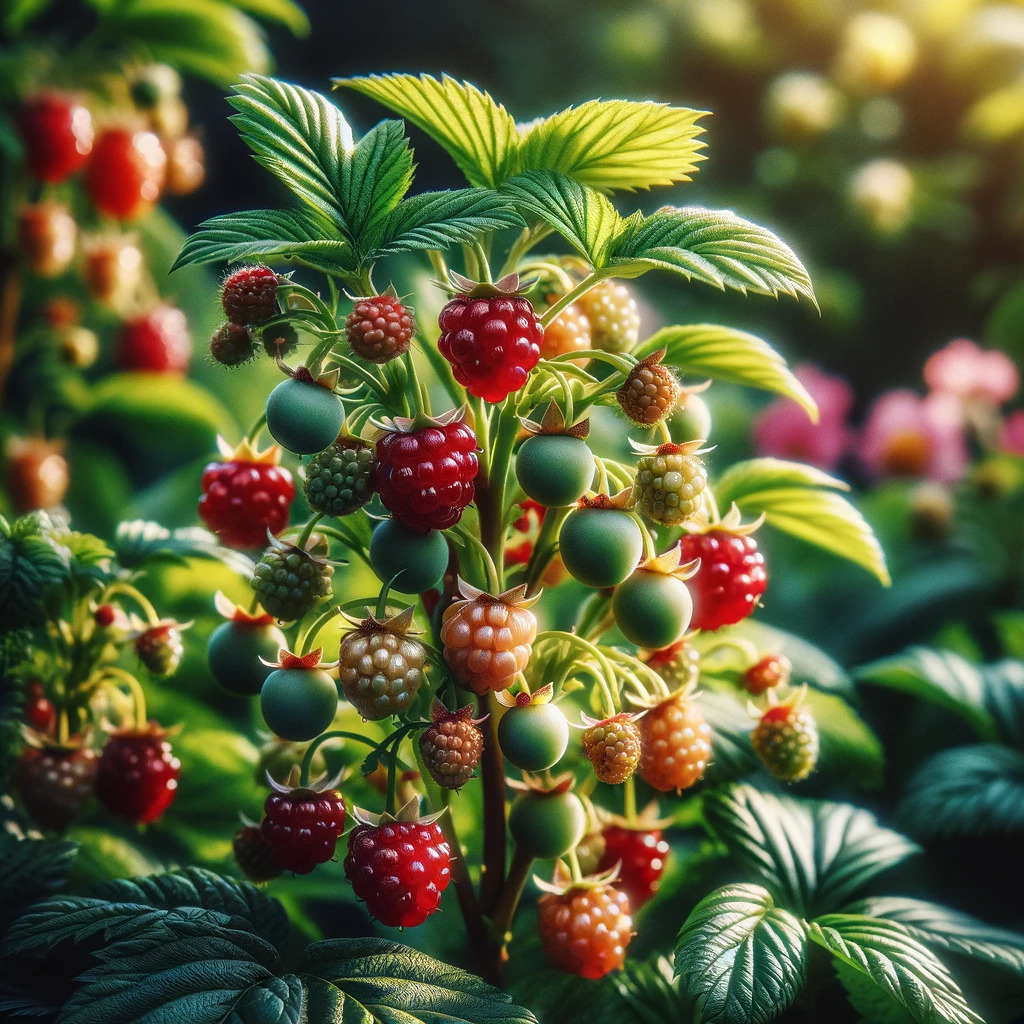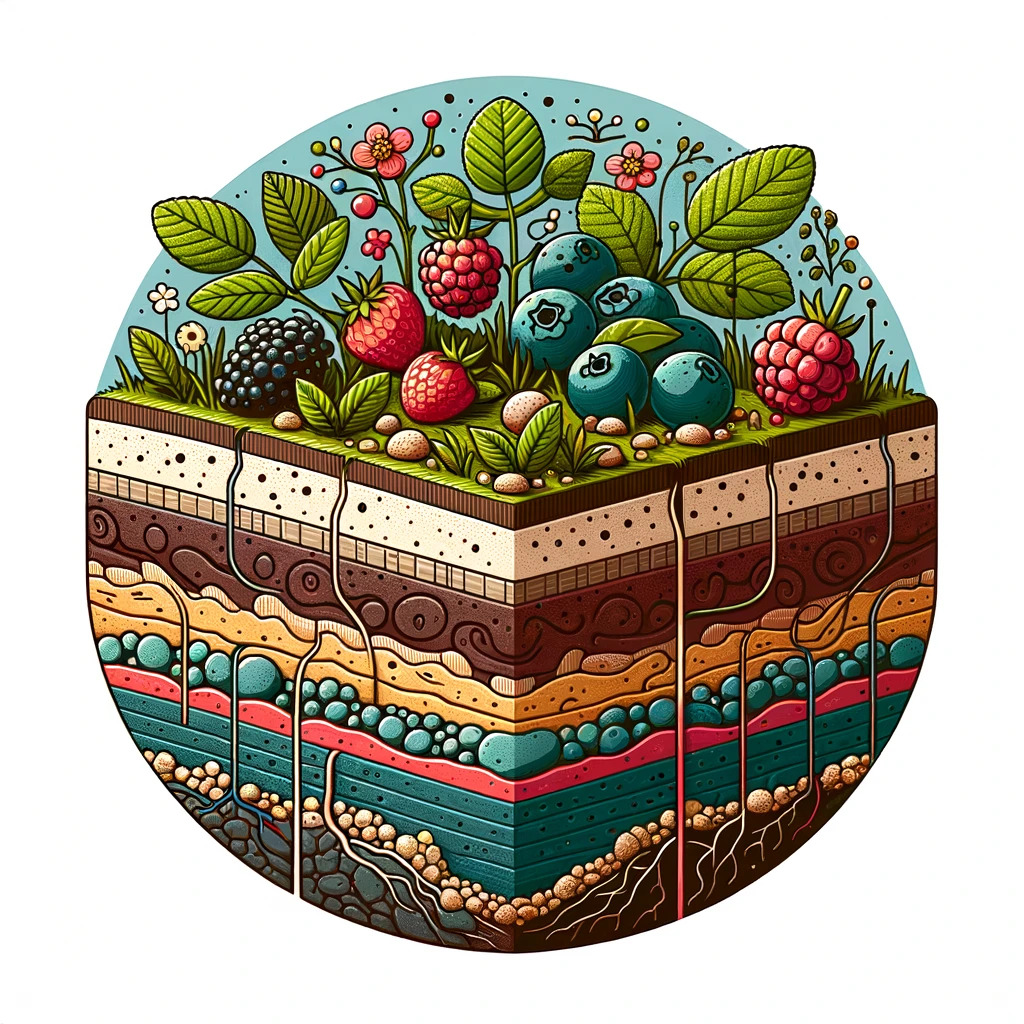What are Berries or Forest Fruits?
“Berries” or forest fruits are a diverse group of small fruits, generally juicy and sweet, characterized by their high content of nutrients and antioxidants. From a technical point of view, the term “berry” has different interpretations in botany and culinary use.

Botany
In botany, a “berry” is defined in a specific way. It is a type of simple, fleshy fruit that contains several seeds. Botanical examples of berries include tomatoes, bananas, grapes, and kiwis. Interestingly, many fruits commonly called “berries” in culinary use, such as strawberries and raspberries, are not berries from a botanical perspective.
Culinary Use
In culinary use, the term “berry” is applied more broadly to small fruits that can be sweet or sour and are commonly consumed fresh or in a variety of culinary preparations. This category includes:
- Strawberries (Fragaria spp.): Technically not berries in the botanical sense; they are aggregate fruits that develop from a flower with multiple ovaries.
- Blueberries (Vaccinium spp.): Include varieties like blueberries and cranberries. They are examples of true berries from a botanical point of view.
- Raspberries and Blackberries (Rubus spp.): They are aggregate fruits of drupelets, composed of small drupelets attached to a central structure.
- Currants (Ribes spp.): Include red, black, and white currants. They are examples of true berries in botanical terms.
In summary, “berries” or forest fruits comprise a variety of small fruits, generally juicy, sweet or sour, and highly appreciated for their flavor and nutritional value. Each type of berry has its own unique characteristics in terms of flavor, texture, and culinary uses. They are also known for their nutritional properties, including vitamins, minerals, fiber, and antioxidants, making them popular in healthy and varied diets.

Some of the Most Common Types of Berries
Common Berries
- Strawberries (Fragaria spp.)
- Blueberries (Vaccinium corymbosum)
- Cranberries (Vaccinium macrocarpon)
- Raspberries (Rubus idaeus)
- Blackberries (Rubus spp.)
- Red Currants (Ribes rubrum)
- Black Currants (Ribes nigrum)
- Gooseberries (Ribes uva-crispa)
- Goji Berries (Lycium barbarum and Lycium chinense)
- Acai Berries (Euterpe oleracea)
- Elderberries (Sambucus spp.)
- Wild Blueberries (Vaccinium myrtillus)
- Blackberries (Rubus fruticosus)
- Maqui Berries (Aristotelia chilensis)
- Schisandra Berries (Schisandra chinensis)
- Sea Buckthorn Berries (Hippophae rhamnoides)
Less Common Berries
- Haskap or Honeyberries (Lonicera caerulea)
- Loganberries (a cross between raspberries and blackberries)
- Tayberries (a cross between raspberries and blackberries)
- Boysenberries (a cross between raspberries, blackberries, and loganberries)
- Mulberries (Morus spp.)
- Chokeberries or Aronia (Aronia melanocarpa)
- Goldenberries or Cape Gooseberries (Physalis peruviana)
- Juneberries or Saskatoon Berries (Amelanchier spp.)
- Lingonberries or European Cranberries (Vaccinium vitis-idaea)
- Salmonberries (Rubus spectabilis)
- Cloudberries (Rubus chamaemorus)
- Barberries (Berberis spp.)
- Bignay Berries (Antidesma bunius)
- Jabuticaba Berries (Plinia cauliflora)
It is worth noting that the availability and popularity of these fruits can vary considerably depending on the region. Additionally, some of these “berries” may not be berries in the strict botanical sense, but are commonly classified as such in culinary and commercial use.
Soil and Climate Requirements Necessary for Good Berry Development

Berries, being a diverse group of plants, have specific soil and climate requirements that vary according to the species. Below, some of the general requirements for the successful cultivation of the most common berries, as well as alternative cultivation options, are detailed:
Soil and Climate Requirements
- Strawberries:
- Soil: Prefer well-drained soils, rich in organic matter, with a pH between 5.5 and 6.5.
- Climate: Temperate climates are ideal; however, some varieties can tolerate colder conditions.
- Blueberries:
- Soil: Require acidic soils with a pH between 4.5 and 5.5, well-drained and rich in organic matter.
- Climate: Prefer temperate to cold climates; some varieties are resistant to low temperatures.
- Raspberries and Blackberries:
- Soil: Well-drained, fertile soils with a slightly acidic to neutral pH (5.5 to 7.0).
- Climate: Adapt to a wide range of climates but prefer moderate temperatures.
- Red and Black Currants:
- Soil: Prefer moist, well-drained, nutrient-rich soils.
- Climate: Develop best in cooler climates and can tolerate partial shade.
Alternative Cultivation Options
- Hydroponics:
- Some berries, like strawberries, can be successfully grown in hydroponic systems, which allow precise control of nutrients and pH, and optimize water use.
- Container Cultivation:
- !
- Ideal for limited spaces or non-ideal soils. Containers allow for soil quality control and facilitate drainage. This is a popular option for cultivating blueberries, especially in areas with alkaline soils.
- Greenhouses:
- Allow for extending the growing season and protecting plants from adverse weather conditions. Greenhouses are useful for temperature regulation and protecting berries from excessive rain or frost.
- Mulching:
- Applying a layer of organic mulch helps maintain soil moisture, control soil temperature, and suppress weeds. It is beneficial for almost all types of berries.
- Soil pH Modification:
- For crops like blueberries that require acidic soils, the soil pH can be modified by adding aluminum sulfate or peat.
- Covers or High Tunnels:
- Used to protect berry plants from intense rain or hail, and to control sun exposure.

Additional Considerations
- Crop Rotation: Avoid planting berries in soils where plants susceptible to similar diseases have previously been cultivated.
- Water Management: Ensure proper and consistent irrigation, avoiding waterlogging.
- Pest and Disease Control: Implement integrated pest and disease management practices to keep plants healthy.
Planning and Preparing the Land for Berries
Planning and preparing the land are crucial steps in the successful cultivation of berries. Here’s how to approach each of these stages:
1. Site Selection
- Evaluating Sun Exposure: Most berries require full sun for optimal growth. Look for a site that receives at least 6-8 hours of direct sunlight a day.
- Considering Wind Protection: A site sheltered from strong winds is ideal, as they can damage plants and dry out the soil.
- Water Access: Ensure that the site has easy access to water for irrigation.
- Environment Evaluation: Avoid areas prone to flooding or near large trees that may compete for nutrients and water.

2. Soil Preparation
- Step 1: Soil Analysis
- Collect Soil Samples: Take several samples from different parts of the site for a comprehensive analysis.
- Send Samples to a Laboratory: A lab analysis will provide information on pH and nutrient levels.
- Interpreting the Results: Understanding the results will help you determine what amendments are needed.
- Step 2: Adjusting pH and Nutrients
- If the pH is Too High (Alkaline): For crops like blueberries that require acidic pH, add aluminum sulfate or peat to lower the pH.
- If the pH is Too Low (Acidic): Use lime to raise the pH in overly acidic soils.
- Add Nutrients as Needed: Based on the soil analysis results, you may need to add fertilizers rich in nitrogen, potassium, phosphorus, or organic matter.
- Step 3: Tilling and Conditioning the Soil
- Loosen and Aerate the Soil: Use a plow or hoe to loosen and aerate the soil to a depth of 30-40 cm.
- Incorporate Amendments: Mix the recommended soil amendments during the tilling process.
3. Drainage
- Evaluating Natural Drainage: Observe how water accumulates or drains after heavy rain. Persistent puddles are a sign of poor drainage.
- Building Raised Beds: If drainage is an issue, consider constructing raised beds to improve drainage.
- Installing Drainage Systems: For severe drainage problems, you might need to install underground drains or drainage ditches.
Practical Example for Planting Blueberries (Berries):
Suppose you want to plant blueberries:
- Choose a sunny and wind-protected site.
- Conduct a soil analysis and find out that the pH is 6.5 (too high for blueberries).
- Add aluminum sulfate according to recommendations to lower the pH to 4.5-5.5.
- Till the soil, incorporating peat to increase acidity and improve soil structure.
- If drainage is insufficient, construct raised beds 30-40 cm high.
By carefully following these steps, you can create an optimal environment for growing berries, maximizing your chances of obtaining an abundant and high-quality harvest.

In the following article, we will provide more details on Berry Planting Guides, irrigation, pest and disease control Harvest, Postharvest, commercial aspects, sustainability, and best practices.
 AgronoBlog – Agriculture Blog
AgronoBlog – Agriculture Blog 

